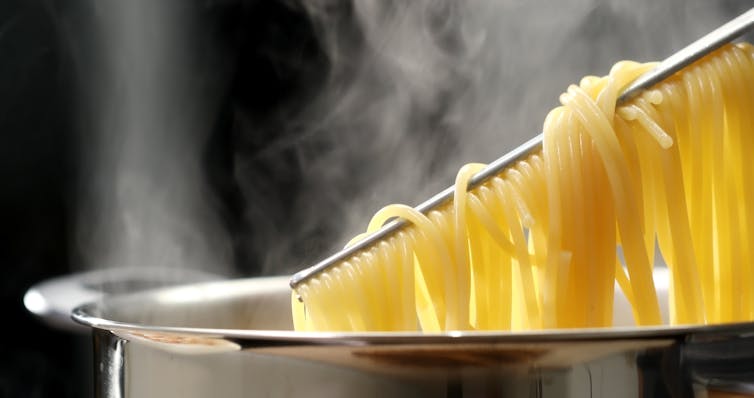[ad_1]
Whether you prefer your spaghetti al dente or soothingly soft, it can be difficult to achieve perfection at home. Many of us will have experienced our pasta disintegrating into a beige mush – particularly for gluten-free alternatives.
So how much water and salt do you really need, and how long do you cook it for if you want optimal results? What’s more, how should you amend your cooking process when using gluten-free pasta? A recent study my colleagues and I conducted, published in Food Hydrocolloids, has provided answers by unveiling the physics behind the cooking process.
Turning to the Diamond light source, the UK’s national synchrotron (a circular particle accelerator) facility, we studied the scattering of X-rays off pasta (at low angles) to uncover its internal structure. Then we went to Isis and to the Institute Laue Langevin, which are neutron facilities in the UK and France, and used neutrons (which make up the atomic nucleus along with protons) to shed light on the microstructure of regular and gluten-free spaghetti under different cooking conditions.
The study shows how the hidden structure of pasta changes as it cooks, and why gluten-free versions behave so differently.
The setup enabled us to investigate the structure of starches and gluten within spaghetti on small scales that spanned from tens of times the radius of an atom to thousands of times. In this way, we could compare the transformation that happens in regular and gluten-free pasta while they are cooked in different conditions, such as being cooked for too long or cooked without salt.
Our experiments allowed us to “see” different components of the pasta separately. By mixing normal and “heavy water” (which contains an isotope called deuterium), we could make either the gluten or the starch invisible to the neutron beam. In this way, we could effectively isolate each structure in turn, and understand the effects of starches and gluten during cooking.
The power of gluten and salt
Our study reveals that, in regular pasta, the gluten acts as a strong scaffold that holds starch granules in place even during boiling, giving the pasta its firmness and slow digestion rate. In gluten-free pasta, the starch granules swell and collapse more easily – explaining the mushy texture and faster breakdown experienced when this kind of pasta is cooked in non-optimal conditions.
We also probed the effect of salt in the cooking water on the pasta structure. What we found is that salt doesn’t just make pasta taste better; it also strongly affects the microstructure of the spaghetti. When regular pasta is boiled in salted water, the gluten maintains its structure, and the starch granules are less deteriorated by the cooking process.
So how much salt should you add to preserve the pasta’s microscopic structure? Our study revealed that the optimal salt level is seven grams per litre of water, with more water required for larger amounts of pasta. The pasta should be cooked ten or 11 minutes in the case of regular and gluten-free altertnative, respectively. In contrast, when the salt concentration was doubled, the internal order broke down more rapidly and the structure within the starches granules was significantly altered by the cooking process.

Kalashnikov Dmitrii/Shutterstock
In gluten-free pasta, the story was different again due to the lack of protection of gluten. Even small amounts of salt couldn’t compensate for the absence of gluten. Artificial compounds of processed starches, used by companies to substitute the gluten, degraded fast. The most extreme example of this degradation occurred when the gluten-free spaghetti was cooked too long, for instance, for 13 instead of 11 minutes, and in very salty water.
The main finding was therefore that gluten-free pasta is structurally more fragile and less tolerant of being cooked both for too long and with the wrong amount of salt.
Improving gluten-free alternatives
Understanding pasta’s structure on these very small scales, that are invisible even under a microscope, will help the design of better gluten-free foods. In particular, the hope is to obtain gluten-free alternative that are more resilient to bad cooking conditions and are more similar in texture to regular spaghetti.
Regular wheat pasta has a low glycaemic index because the gluten slows how starch granules are broken down during digestion. Gluten-free pasta, made from rice and corn flour, often lacks this structure, meaning sugars may be released faster. With neutron scattering, food scientists can now identify which ingredients and cooking conditions best recreate gluten’s structure.
This is also a story about how cutting-edge experimental tools, mainly used for fundamental research, are transforming food research. Neutron scattering played a fundamental role in advancing our understanding of magnetic materials, batteries, polymers and proteins. Now it is also helping us to explain how everyday foods behave at the microscopic level.
![]()
Andrea Scotti receives funding from the Knut and Alice Wallenberg Foundation, and the Swedish Research Council.
[ad_2]
Source link



